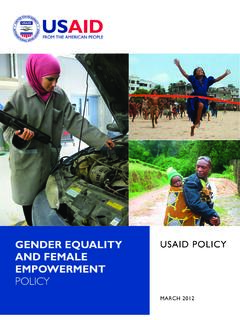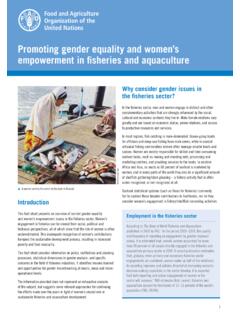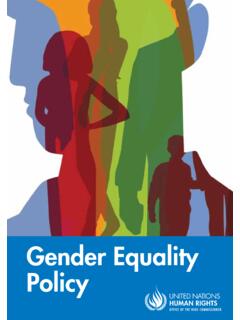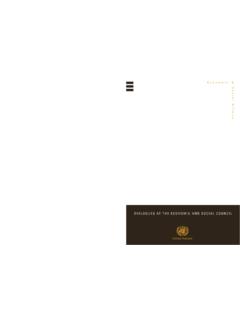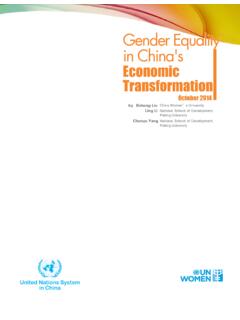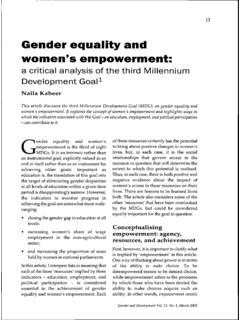Transcription of Gender inequalities in South African society
1 Volume One - Number Six - August 2001. Gender inequalities in South African society South Africa's national policy framework for women's empowerment and Gender equality , which was drafted by the national Office on the Status of Women, was the focus of two hearings held in Durban last month. These gave participants from government and civil society the opportunity to discuss priority issues for national and provincial action plans, recommend structures and institutions for implementation and debate areas for cooperation between civil society and the Office on the Status of Women.
2 The policy framework outlines South Africa's vision about Gender equality and what the country intends to do to realise this ideal. It establishes guidelines for South Africans to take action in remedying the historical legacy by defining new terms of reference for interactions in the private and public spheres, and by proposing and recommending an institutional framework that facilitates equal access to goods and services for women and men. It also proposes a process that moves away from treating Gender issues as 'something at the end of the day business'. The framework states that in discussing development issues it is often presumed that Gender issues can be addressed after the debate around 'hard-core issues'.
3 The policy framework attempts to ensure that the process of achieving Gender equality is at the very centre of the transformation process. The central principles of the framework are developed from the ideal contained in the Constitution under the Bill of Rights,which promotes the rights of all citizens irrespective of race, Gender , class or age. The contents of the policy framework will be the primary focus of KwaZulu-Natal's Office on the Status of Women which is being established in the Department of the Premier of KwaZulu-Natal Lionel Mtshali, according to an announcement at the provincial hearing.
4 However, concerns have already been expressed about the capacity of the office, which has a small staff, to make an impact. This is largely because of the extent to which the inequalities are embedded in South African society . This is detailed in a chapter of the policy framework entitled situational analysis and problem statement, which aims to provide a global view of the critical issues that impact on South Africa's progression towards Gender equality . Legal framework Perspectives on KwaZulu-Natal was published by Profile KwaZulu-Natal cc in 2001 and 2002. All rights reserved.
5 No editorial material published in Perspectives on KwaZulu-Natal may be reproduced in any form without prior written permission from, and acknowledgement to, Cheryl Goodenough. Perspectives on KwaZulu-Natal was proofread by Donna Hornby from Absolute Proof. Copyright Profile KwaZulu-Natal cc, 2001, 2002. In its attempt to reverse the history of women's discrimination and marginalisation, the government since 1994 has passed a Facts and figures number of laws developed to promote equality between women and men regardless of race, class, disability and sexual orientation.
6 These laws protect the In 1999, 36% of household heads were reported to be female. interests of women and men in the family, the criminal justice system, employment health, property, education and training, In 1995 four percent of women headed rural households fell among the wealthiest fifth of households. governance and institutional support and . general equality . Over 37% of rural women-headed households and 15% of urban women-headed households were The legislation includes the Domestic among the poorest fifth of Violence Act, Witness Protection Act, Choice households.
7 On Termination of Pregnancy Act, Housing . Act, South African Schools Act, Electoral Act 35% of economically active black and Film and Publication Act. women were unemployed in October 1999 compared to 25% of black women. The new and enabling legislation must be activated to ensure that women feel the remedies inherent in these measures. In addition, there are still some gaps that need 49% of employed black women were working in 'elementary' or 'unskilled'. occupations such as cleaning, to be addressed. Examples include African garbage collecting and farm work, customary law, which is still based on the compared to 21% of black men.
8 1927 law that disinherits women. Women and poverty Figures for 1999 indicate the in non- urban areas, 30% of all households were having to fetch wood for cooking and heating purposes. The last decade has witnessed a marked . increase in the number of poor across the 44% of those who fetch wood had to world and South Africa is no exception. In travel more than a kilometre to do determining poverty rates, the usual so. It is usually the women who perform these tasks. approach in South Africa is to consider the poorest 40% of households as 'poor'. Adopting this definition, poverty is found to be concentrated in rural areas, and among black people.
9 Close to three-quarters (71%) of all rural households are poor. Over three in five (61%) of black households are poor, compared to 38% of coloured households, five percent of Indian and one percent of white. A number of factors contribute towards the poverty of women in South Africa. The gendered division of labour in the household, the low value accorded to women's work with the concomitant clustering of women in low paid jobs contributes to female poverty. Past discriminatory civil and traditional laws that have denied women access to land, loans and property have also hindered women's ability to be self-sufficient.
10 Women and education In 1999 17% of black women aged 20 years and younger received no formal education. Perspectives on KwaZulu-Natal was published by Profile KwaZulu-Natal cc in 2001 and 2002. All rights reserved. No editorial material published in Perspectives on KwaZulu-Natal may be reproduced in any form without prior written permission from, and acknowledgement to, Cheryl Goodenough. Perspectives on KwaZulu-Natal was proofread by Donna Hornby from Absolute Proof. Copyright Profile KwaZulu-Natal cc, 2001, 2002. Domestic responsibilities lead to school absenteeism for girls, especially in rural areas.


